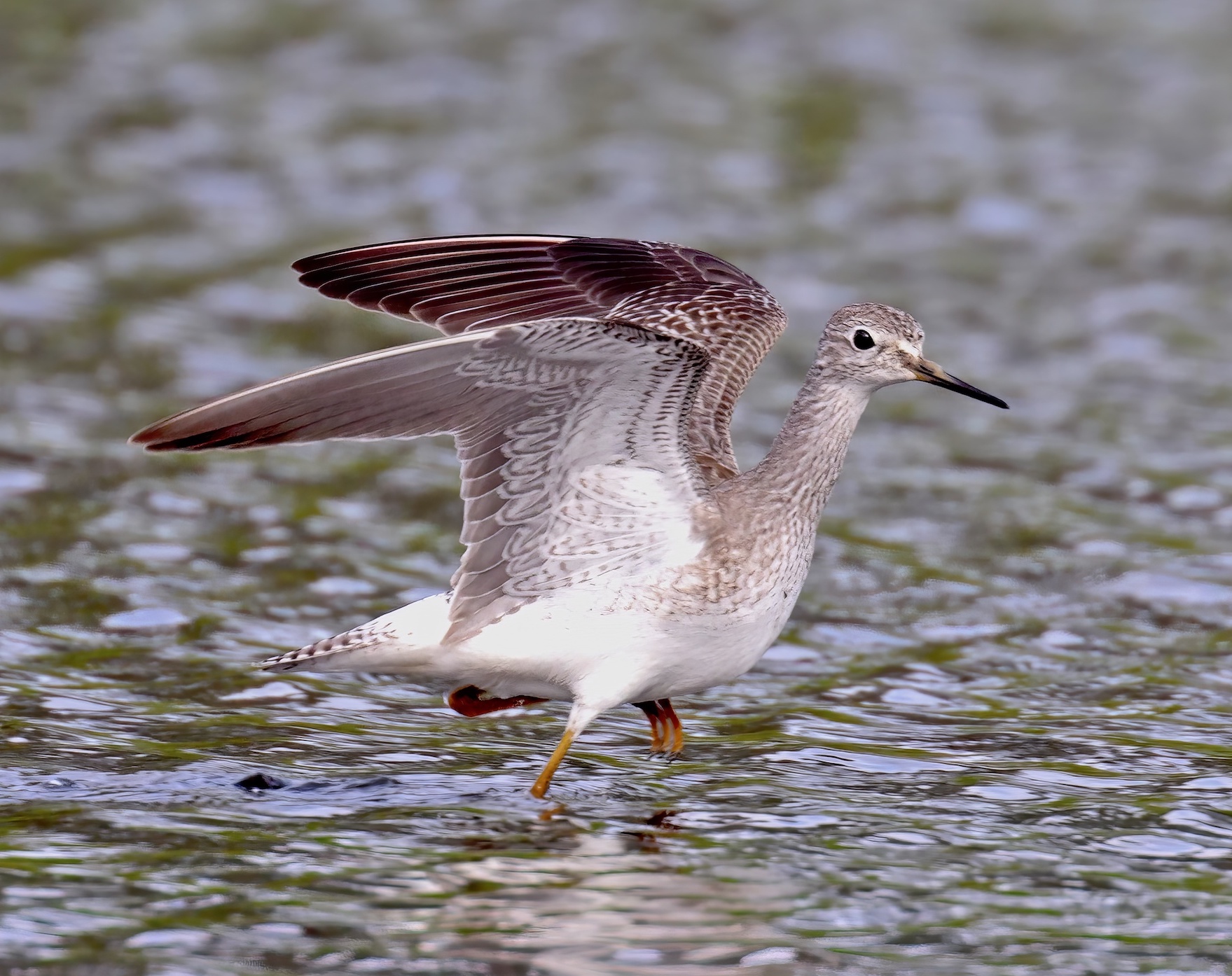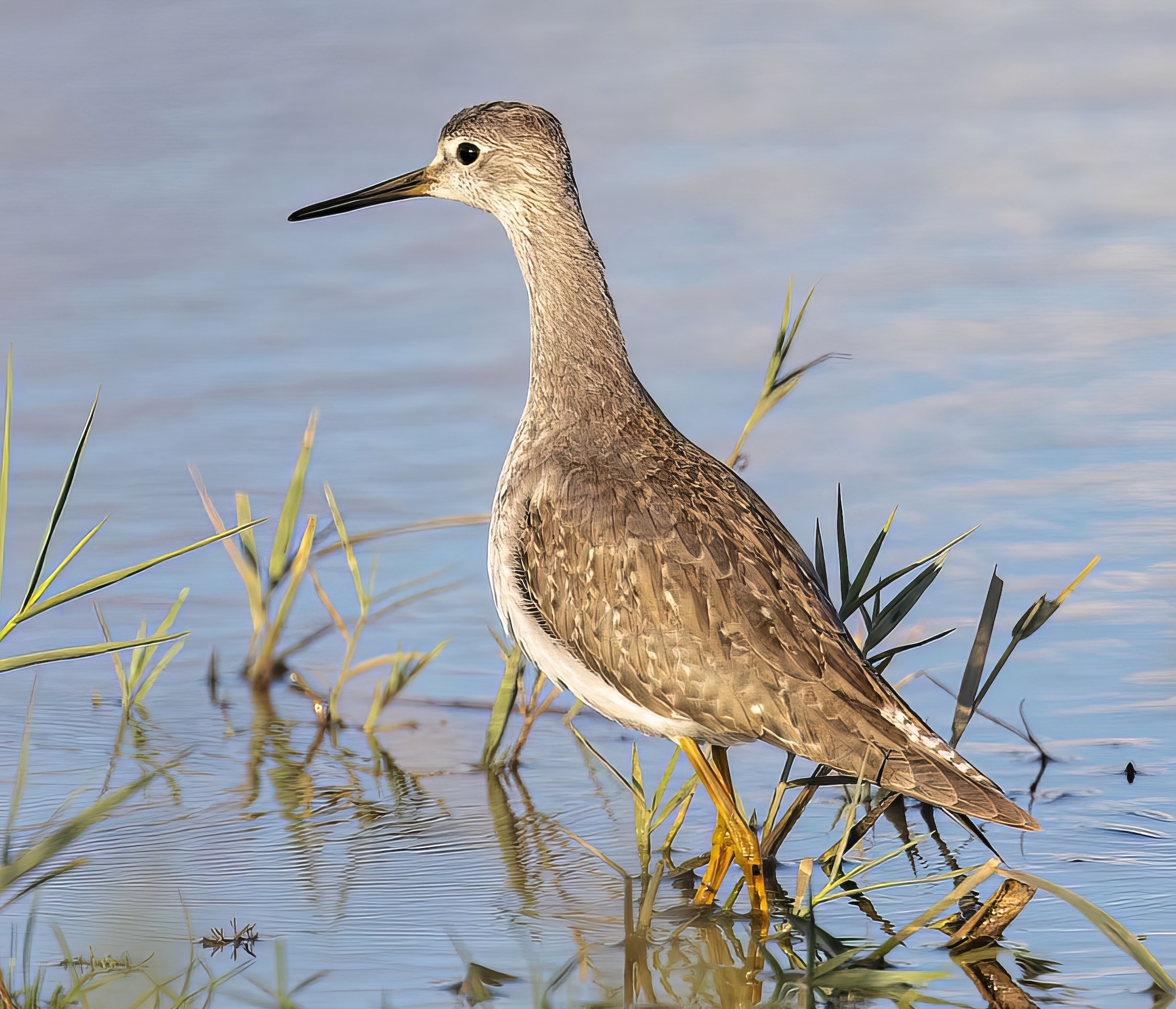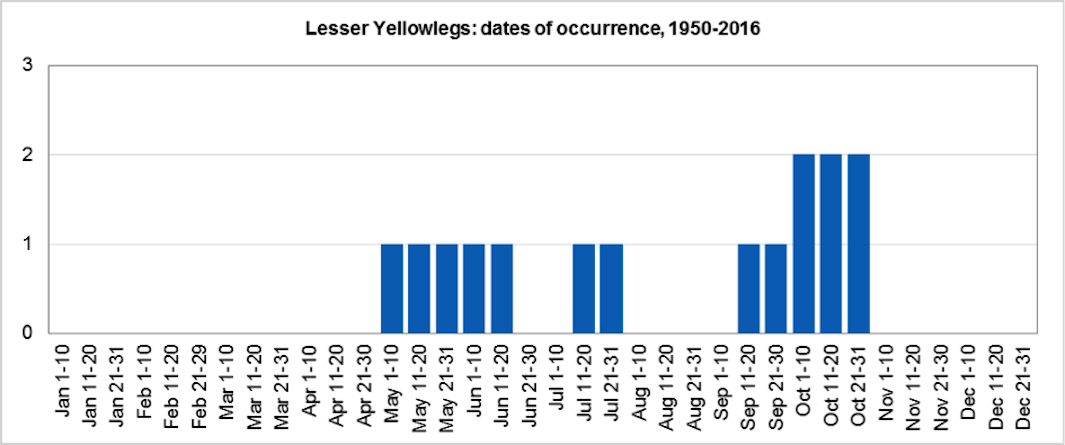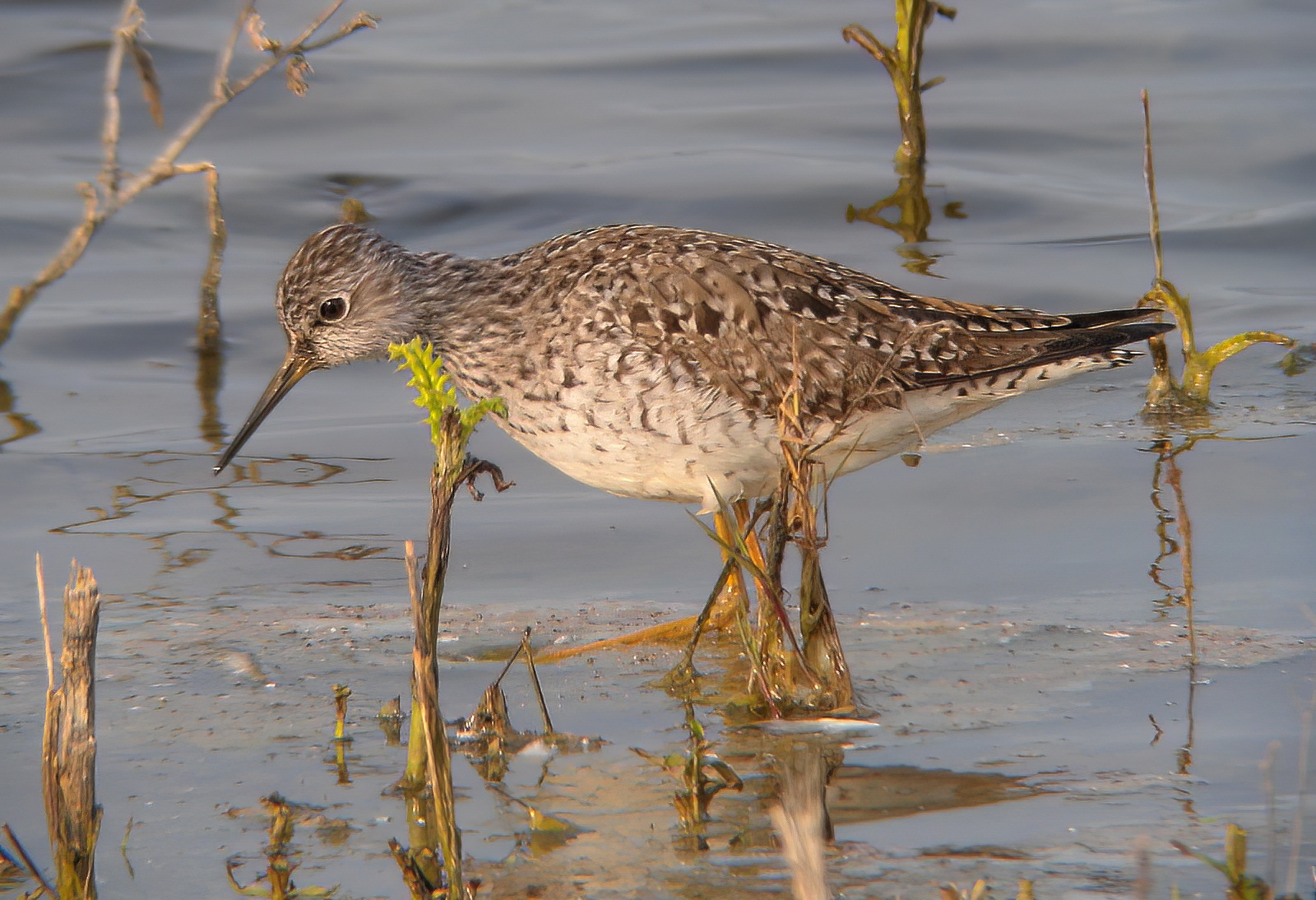Lesser Yellowlegs Tringa flavipes


Lesser Yellowlegs: left, Frampton Marsh May 5th 2010 (Paul Sullivan); centre, Butterwick Hale October 7th 2016 and right, 2CY bird Alkborough Flats
October 8th 2020 (both Graham Catley).
The first bird recorded in the county was shot at Tetney in Sep 1932, with 20 records in all up to 2020 involving 17 birds. There were seven records during 1966-90, none 1991-2001, then 12 during 2002-2020 probably involving only nine birds. There have been three records in May and June, two in July, three in September, six in October and singles in November-January thanks to the long stayer at Bagmoor Floods and Alkborough Flats October 2011-January 2012. This bird was a moulting juvenile when first found in October 2011 and it was presumed to be the same bird which later returned to Alkborough Flats in October 2012 (This bird is included in the chart for both arrival dates). They appear to favour sites offering largely freshwater or saline pools. The later period after 2000 coincided with the inception of more wetland sites in the county on The Humber and The Wash and elsewhere inland, all very welcome developments. BBRC statistics show that during 1950-2018 there were 387 records with a significant minority referring to birds returning to favoured sites. They average about nine records per year but with some double-figure totals recently peaking at 17 in 2011 and 20 in 2016.
| Site | First date | Last date | Count | Notes |
| Cow marsh, Tetney | 15/09/1932 | - | 1 | Shot |
| Wisbech STW | 17/09/1966 | - | 1 | |
| North Killingholme Pits | 03/10/1970 | 30/10/1970 | 1 | |
| Wisbech STW | 11/10/1973 | - | 1 | |
| Huttoft Pit LWT reserve | 25/07/1976 | 05/08/1976 | 1 | Adult |
| Humberston Fitties | 24/09/1978 | - | 1 | |
| Covenham Reservoir | 20/05/1984 | - | 1 | Adult |
| Gibraltar Point NNR | 15/06/1990 | - | 1 | Adult |
| Freiston Shore | 31/05/2002 | - | 1 | Adult |
| North Killingholme Pits | 16/10/2005 | 22/11/2005 | 1 | 1CY |
| Freiston Shore | 07/06/2006 | 09/06/2006 | 1 | |
| Gibraltar Point NNR | 09/06/2006 | 03/09/2006 | 1 | Same as Freiston bird, seen on and off there between these dates |
| Frampton Marsh | 05/05/2010 | - | 1 | |
| Alkborough Flats & Bagmoor Floods | 30/10/2011 | 08/01/2012 | 1 | 1CY, then 2CY moved between these two sites |
| Alkborough Flats | 28/10/2012 | 08/12/2012 | 1 | 2CY, presumed returning bird of 2011/12 |
| Frampton Marsh | 11/07/2014 | 26/07/2014 | 1 | Adult |
| Butterwick Hale | 06/10/2016 | 09/10/2016 | 1 | |
| Middlemarsh Farm, Skegness | 28/06/2019 | - | 1 | |
| Alkborough Flats | 08/10/2020 | 09/10/2020 | 1 | 2CY |
| Goxhill Haven/East Halton Skitter | 16/12/2021 | - | 1 | Adult, believed returning bird of 2020 |
| Manby Wetlands | 08/06/2023 | - | 1 | Adult |
| Frampton Marsh | 18/09/2023 | 28/06/2024 | 1 | 1CY to 2CY |
| Anderby Marsh | 04/07/2024 | 1 | 2CY, same as Frampton Marsh bird having disappeared north to Anderby for a brief stay | |
| Gibraltar Point | 04/07/2024 | 05/07/2024 | 1 | 2CY bird, same as Frampton & Anderby Marshes bird; departed at 08.40hr. on July 5th. |
| Frampton Marsh | 05/07/2024 | 01/08/2024 | 1 | 2CY, returning long-stayer, arrived back from Gibraltar Point July 5th. |

'Yellowshank' in Lincolnshire: first county record.
by G. H. Caton Haig
Note: this account is © British Birds, appearing in volume 26(11):338, (1933). This was one of 19 accepted records up to 1949, since when there have been another 387 up to the end of 2018, after which the species was no longer considered by BBRC.
On September 15th, 1932, an example of the Yellowshank (Tringa flavipes) was shot by Mr. J. H. Stubbs at his plover decoy pool in Tetney Cow Marsh. He recognized the bird as a stranger by its note, which was quite new to him. The bird was apparently by no means shy, as after he had missed a double shot at it, it allowed him to call it back by the imitation of its note. I did not hear of the occurrence for some days and therefore did not see the bird in the flesh. When I saw it at the Louth bird stuffer's it was much covered with string and wrappings, but it’s very long thin legs and noticeably slender bill were characteristic. The legs were pale yellow and the bill black. The measurements taken from the stuffed and cased bird are as follows ; Bill 35 mm., tarsus 57 mm., wing 151 mm. The carpal joint appeared to be slightly distorted and I think the wing would have measured 2 or 3 mm. more in the flesh.
Finder’s report: Lesser Yellowlegs at North Killingholme Pits, October 3rd, 1970, third county record.
by D. Wright, G. K. Brown, and S. Lorand.
Note: this account is taken from the original Rarities Committee submission. This was the third county record and the earliest that we have on file. The RC report for 1970 noted that considering the records separately (as there was some doubt over possible duplications with birds moving between sites) 1970 produced around ten individuals, making a grand total in excess of 88, 53 of them since 1958. The observations of this bird were made by several observers over the period October 5th-8th and extensive notes taken. The submission made by the original finder (DR) appears here, along with some additions from SL.
Circumstances
On October 3rd, 1970, I (DW) paid one of my regular visits to some disused and partly drained brick pits at Killingholme. I observed a bird which was different from any I had seen previously. It was first seen feeding in 2”-3” of water with two Dunlin, one Redshank and one Spotted Redshank close to the shore at a distance of 25-30 yd. from me. The light was very good. Although surrounded oil refineries and other industrial projects, the freshwater pit, with its small grassy islands lies just behind the sea wall and proves attractive to many waders, particularly Tringa sp.
DW watched it from 15.00-17.45 hr. on Oct 3rd. Other observers did so on October 5th, 6th, and 8th.
Description (DW)
Size - slightly smaller than Redshank and more dainty.
Head – crown darkish with a small light stripe above the eye. Bill dark, approximately 1.25-1.5 times head length, straight fairly thin.
Wings – dark with white spots or flecks, not unlike Spotted Redshank at same time of year.
Body – throat and neck streaky grey. Belly white. Rump white. Tail white with small grey bars.
Call – One and sometimes two notes similar to Greenshank but thinner, which in my opinion suggests Lesser Yellowlegs.
Supplementary notes (SL)
October 5th
Overall, a very clean and delicate bird, the plumage recalling a winter Spotted Redshank and the build resembling a large Wood Sandpiper. Bill rather fine and straight, 1.25-1.3 times the head length. Legs long especially above the tarsal joint. Wing tips equal to tail. Head neatly rounded on fairly long, slender neck and small in comparison to moderately long, tapering body. Generally grey on the crown and upperparts, suffusing paler on lores and ear coverts. No supercilia apparent. Underparts pure white. Bill blackish and legs quite yellow.
In flight the bird was more impressive. The white rump patch was clearly discerned to be squarish and quite sharply demarcated from the dark tail and back. Wings long and pointed and noticeably dark and lacking any paler markings. Legs projected well beyond tail. As the bird flew away it called 5-6 times, a loud ringing “chee-u”, higher pitched than Greenshank and lacking the carrying power of that species.
October 8th
Watched for the whole morning at ranges of 40-70 yd. Crown medium grey, flecked blackish, suffusing brown-grey on nape and side of neck. Mantle and wing coverts darker, tending towards umber, tipped, and slightly edged buffish-white. Primaries blackish-brown. Very pale grey-buff on breast suffusing pure white on belly and undertail coverts. At minimum range a small amount of black passed through the eye to produce an indistinct supercilium above it. Lores and ear coverts white. Legs very yellow and bill black, tinged pinkish at base of lower mandible.
References
British Birds Rarities Committee: List changes, 1st January 2019. Lesser Yellowlegs to be assessed by county records committees. https://www.bbrc.org.uk/1907
Denton, M.L. (1995). Birds in the Yorkshire Museum. Yorkshire Museum, York.
(Account prepared October 2017; updated with reference to the new Birds of Lincolnshire (2021) October 2022)


